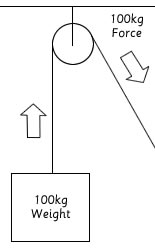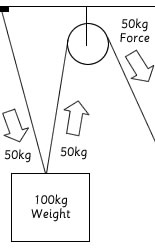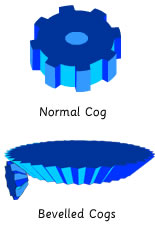Pulleys
Pulleys help machines (and people) lift heavy things more easily.
When you use a single pulley to lift a weight the only thing that changes is the direction of the force.
To lift the weight up you need to pull the rope down.
You need to use 100kg of force to keep the weight held up, and have to pull 1m of rope to lift the weight 1m.

This time one end of the rope is attached to the ceiling before it is attached to the weight; this spreads the load between the person pulling the rope and the ceiling.
When I pull on the rope I only need to use 50kg of force to lift the 100kg weight, but I will need to pull 2m of rope to lift the weight 1m.
If I add more pulleys in different combinations, I can use a smaller and smaller force to lift larger and larger weights. Clever, isn’t it!

Cogs and gears
Cogs are special wheels which have teeth cut into them to help them mesh with other cogs. When you turn a cog the teeth will cause any cogs touching it to turn as well, which is pretty useful if you are building moving machines.
The really clever part comes when you put cogs of different sizes together with different sized teeth. If you had one small cog with 10 teeth around the edge touching a larger cog with 20 teeth around the edge then you would need to turn the smaller cog twice to make the larger cog turn once.

This is because of ratio. The ratio of teeth is 10:20 or 1:2.
If you have a cog with 40 teeth touching a smaller cog with just 10 teeth, you can turn the larger cog just once and the smaller cog will turn 4 times. Likewise, you would have to turn the smaller cog 4 times to make the big cog turn once. This is because the ratio of teeth on these two cogs is 10 teeth on the small cog to 40 on the big cog, or 10:40 or 1:4.
Cogs can also be used to change the direction of turn by locking them together at 90° using bevel gears (a special type of cog).